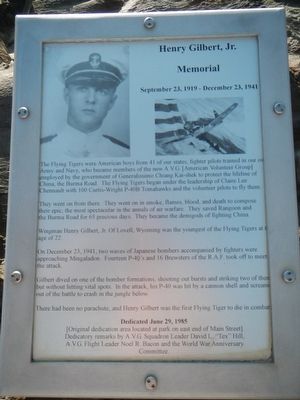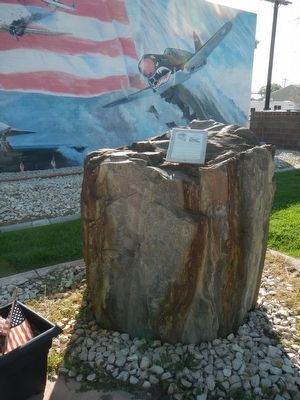Lovell in Big Horn County, Wyoming — The American West (Mountains)
Henry Gilbert, Jr. Memorial
September 23, 1919 - December 23, 1941
They went on from there. They went on in smoke and flame and blood and death to compose their epic; (one of) the most spectacular in the annals of air warfare. They saved Rangoon and the Burma Road for 65 precious days. They became the demigods of fighting China.
Wingman Henry Gilbert, Jr. of Lovell, Wyoming was the youngest of the Flying Tigers at the age of 22.
On December 23, 1941, two waves of Japanese bombers accompanied by fighters were approaching Mingaladon. Fourteen P-40’s and 16 Brewsters of the R.A.F. took off to meet the attack.
Gilbert dived on one of the bomber formations, shooting out bursts and striking two of them but without hitting vital spots. In the attack, his P-40 was hit by a cannon shell and screamed out of the battle to crash into the jungle below.
There had been no parachute, and Henry Gilbert was the first Flying Tiger to die in combat.
Dedicated June 29, 1985
(Original dedication area located at park on east end of Main Street)
Dedicatory remarks by A.V.G. Squadron Leader David L. "Tex" Hill, A.V.G. Flight Leader Noel R. Bacon and the World War Anniversary Committee
Erected 1985.
Topics. This memorial is listed in these topic lists: Air & Space • War, World II. A significant historical date for this entry is December 23, 1941.
Location. 44° 50.232′ N, 108° 23.425′ W. Marker is in Lovell, Wyoming, in Big Horn County. Memorial is on East Main Street (U.S. 310) near Montana Avenue, on the right when traveling east. Touch for map. Marker is at or near this postal address: 112 East Main Street, Lovell WY 82431, United States of America. Touch for directions.
Other nearby markers. At least 8 other markers are within 10 miles of this marker, measured as the crow flies. The Jeep (within shouting distance of this marker); The Mormon Colonists (approx. 2.4 miles away); Cowley Log Community Center (approx. 4.9 miles away); Big Horn Academy (approx. 4.9 miles away); Big Horn LDS Stake Office and Tithing Building (approx. 5 miles away); Byron Sessions (approx. 6.1 miles away); Raptors: Winged Hunters of Bighorn Canyon (approx. 9˝ miles away); Sidon Canal (approx. 10 miles away). Touch for a list and map of all markers in Lovell.
More about this memorial. This memorial is located at the Veterans Memorial Center park.
Also see . . .
1. Flying Tigers - Wikipedia. The group first saw combat on 20 December 1941, 12 days after Pearl Harbor (local time). It demonstrated innovative tactical victories when the news in the U.S. was filled with little more than stories of defeat at the hands of the Japanese forces, and achieved such notable success during the lowest period of the war for both the U.S. and the Allied Forces as to give hope to America that it might eventually defeat the Japanese. AVG pilots earned official credit, and received combat bonuses, for destroying 296 enemy aircraft, while losing only 14 pilots in combat. (Submitted on December 5, 2015, by Barry Swackhamer of Brentwood, California.)
2. The Flying Tigers: Claire Chennault and the American Volunteer Group -Acepilot. "Colonel" Claire Lee Chennault had been in China since the mid-Thirties; he called himself "Colonel," though his highest rank had been Major. An outspoken advocate of "pursuit" (as fighter planes were called then), in an Army Air Force dominated by strategic bomber theorists, he alienated many of his superiors. But in China, equipped with P-40's, he developed the basic fighter tactics that American pilots would use throughout the war. The Japanese planes used over China were much more maneuverable than his Warhawks, whose advantages were: speed in a dive, superior firepower, and better ability to absorb battle damage. Chennault worked out and documented the appropriate tactics that capitalized on the relative strengths of the American fighters: intercept, make a diving pass, avoid dogfighting, and dive away when in trouble. This remained the fundamental U.S. fighter doctrine throughout the Pacific War. (Submitted on December 5, 2015, by Barry Swackhamer of Brentwood, California.)
Credits. This page was last revised on June 16, 2016. It was originally submitted on December 4, 2015, by Barry Swackhamer of Brentwood, California. This page has been viewed 690 times since then and 50 times this year. Photos: 1, 2. submitted on December 5, 2015, by Barry Swackhamer of Brentwood, California.

